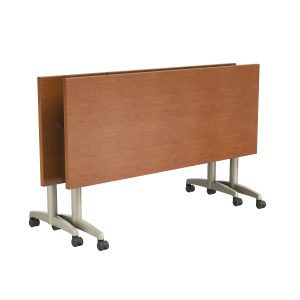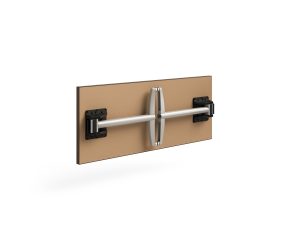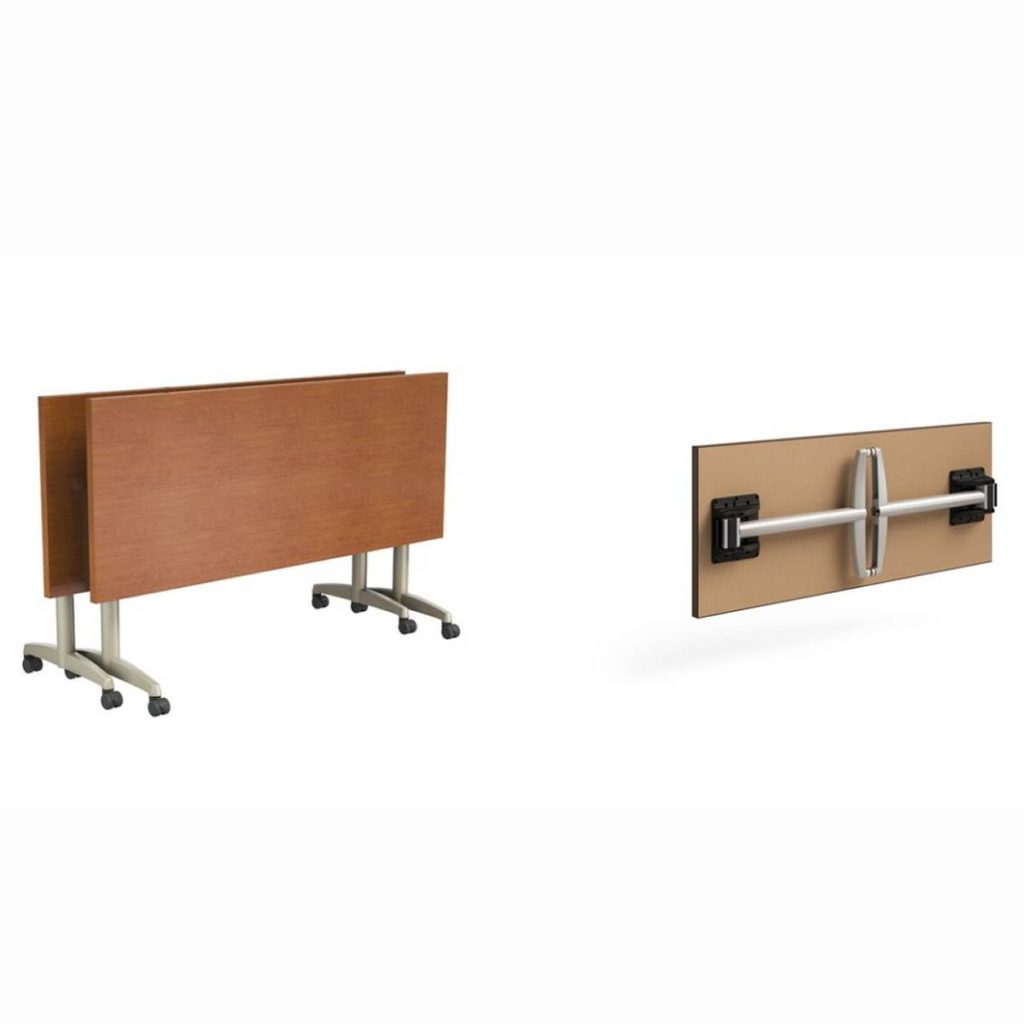As spaces become more versatile and real estate costs continue climbing, the pressure to maximize every square foot has never been greater. That’s where the flip-top versus folding table decision becomes crucial – and frankly, it’s a choice that can make or break your customer’s satisfaction with their furniture investment.
We’ve spent over two decades helping furniture OEMs and dealers navigate decisions like this. From bustling corporate headquarters to intimate training centers, we consistently see how the right table foundations can transform spaces from frustrating to fantastic.
In this guide, we’ll walk through everything you need to know about choosing between flip-top and folding tables. You’ll discover which mechanism suits different applications, how to assess your clients’ real needs (beyond what they might think they want), and why the base manufacturer you choose can make all the difference in a competitive market.
By the end, you’ll have a clear framework for making confident recommendations that keep your clients happy and your business growing.
Preview:
- Understanding the Fundamentals
- Space Efficiency: A Key Consideration
- Matching Solutions to Client Types
- Guiding Client Decision-Making
- Why Manufacturing Quality Matters
- Making the Right Choice
Understanding the Fundamentals
Before deciding on either solution, it’s essential to understand how these mechanisms work and what makes each design unique for your clients.

Flip-top tables feature a mechanism where the tabletop pivots vertically, positioning alongside the table’s legs. When stored, the surface stands upright, often supported by a wheeled base for easy mobility. This design means the tabletop never contacts the ground, virtually eliminating surface damage during storage and transportation.
A flip-top mechanism can incorporate a quick-release system allowing single-person operation. This becomes a key selling point for your clients where setup flexibility matters more than raw storage density.

Folding tables take a different approach, with legs that fold underneath the tabletop, creating a flat profile for storage. When properly stacked, folding tables achieve remarkable storage density, often with specialized trolleys that accommodate multiple tables while providing transport wheels. Quality folding table bases are engineered to withstand the repeated stress of folding and unfolding (while maintaining structural integrity).
Understanding those fundamental differences between the two options helps explain why each design excels in different client scenarios and provides the foundation for making informed recommendations.
Key Differences at a Glance
| Feature | Flip-Top Tables | Folding Tables |
| Storage Method | Vertical, compact footprint | Horizontal stacking |
| Setup Time | 5-10 seconds per table | 30-60 seconds per table |
| Staff Needed | 1 person | 1-3 people |
| Floor Space (stored) | Minimal (1/3 of normal footprint) | Requires stacking area |
| Best for | Quick reconfigurations | Bulk storage needs |
| Transport | Individual rolling | Trolley systems |
Space Efficiency: A Key Consideration
Space efficiency extends beyond storage footprint calculations — it determines how well your tables integrate with customer workflows and operational patterns.
Flip-top tables work quite well when your clients have limited storage space but need frequent reconfiguration. Because each table functions independently with casters, they can be stored in narrow spaces, closets, or corridors. This flexibility proves valuable for buildings without dedicated storage rooms or multi-floor facilities.
The vertical storage position works well under lower ceilings, requiring only slightly more clearance than when the tables are in use. Individual mobility eliminates separate transport equipment needs (i.e., carts or trolleys), allowing single-person operation that reduces your clients’ labor requirements and speeds up room transitions.
Folding tables achieve superior storage density for large quantities. Well-designed storage trolleys can hold numerous tables in a smaller footprint than individual flip-top tables require. This efficiency is particularly important for venues hosting large events or facilities storing dozens of tables. Specialized folding table bases maximize this storage advantage by ensuring tables stack securely without compromising stability.
Transportation considerations add another efficiency layer. Flip-top tables navigate hallways and elevators easily but require multiple trips for large quantities. Folding tables allow teams to transport entire room configurations simultaneously, though maneuvering larger trolleys requires a certain degree of planning.
Client Decision Framework
Guide your clients through these four fundamental questions:
- How often will they reconfigure spaces (daily, weekly, monthly)?
- Who will handle setup and breakdown (varied staff, volunteers, dedicated teams)?
- What are their storage constraints (space, ceiling height, distribution needs)?
- How many tables do they need (small quantities vs. large inventories)?
Understanding their reconfiguration frequencies, staff capabilities, storage constraints, and quantity requirements enables you to better help them choose the best product for their needs. For example, daily or weekly reconfigurations favor flip-top ease of operation, while monthly changes might make folding tables’ complexity acceptable for storage efficiency benefits.
Clients changing layouts frequently with limited staff benefit from flip-top advantages, while those setting up large events with dedicated teams may prefer folding tables’ storage efficiency.
Matching Solutions to Client Types
Understanding when each table type excels helps you identify the right solution for different customer profiles and applications. Let’s take a look at some of the more common ones:
Corporate and Conference Applications
Corporate clients may frequently need to accommodate varying group sizes, from intimate strategy sessions to larger departmental meetings. Flip-top tables allow quick reconfiguration without requiring multiple staff members or complex coordination — a key selling point for busy corporate environments.
Aesthetic considerations in many corporate settings also favor flip-top designs. The cleaner storage profile and reduced handling minimize damage risk to conference room walls, artwork, and technology installations. When executives set up their own meeting spaces, single-person operation capability proves invaluable.
Folding tables serve corporate training centers and seminar facilities well, where the focus is to accommodate larger groups in consistent configurations. Their cost-effectiveness when purchasing in quantity appeals to budget-conscious clients. Training room tables with folding mechanisms offer excellent value for clients who need to maximize seating capacity within budgetary constraints.
Educational and Training Facilities
Modern educational environments showcase both solutions’ respective strengths. Customers emphasizing collaborative learning benefit from flip-top flexibility, allowing instructors to reconfigure spaces from traditional rows to small groups during class time. The reduced noise during reconfiguration minimizes disruption to adjacent classrooms or conference rooms. Training room tables that feature flip-top mechanisms allow for quick transitions between lecture and interactive learning formats.
Large lecture halls and seminar spaces often favor folding tables for their storage efficiency and setup speed when handled by facilities teams. Additionally, the ability to quickly deploy uniform configurations serves traditional educational models effectively. Nesting tables provide an additional space-saving option for educational clients who need maximum flexibility in smaller training environments.
Event and Community Applications
Event venues and community centers face different challenges. When hosting large gatherings, folding tables’ storage efficiency and rapid deployment often outweigh any handling complexity. Professional event staff can easily transform spaces using systematic setup procedures.
Hotels with convertible meeting spaces appreciate flip-top mobility and damage resistance. Guest services staff can reconfigure meeting rooms without specialized training while maintaining the premium appearance hotels require.
Specialized Client Considerations
Key factors that influence recommendations include:
- Available staff physical capabilities and training levels
- Storage space limitations and accessibility requirements
- Event frequency and setup complexity needs
- Budget constraints and long-term value expectations
Guiding Client Decision-Making
Helping clients choose correctly takes systematic evaluation of their specific situations rather than relying on general preferences or assumptions. Important factors here include customer cost and the support they will receive.
Investment Analysis
Evaluate total project costs across these categories:
- Initial Investment. Purchase price plus required accessories and training
- Operational Costs. Maintenance, staff time, and setup efficiency
- Staff Efficiency. Time savings during reconfiguration activities
- Long-term Factors. Replacement schedules and service requirements
As with any investment, it is important to consider both the cost and return. Going back to a point we touched on just a moment ago, not having to buy a replacement table sooner may justify a higher price point in the present. For some customers, though, that might not be as much of a concern. And that makes it important to understand their situation.
Implementation and Support
Successful installations benefit from strategic guidance:
- Recommend starting with smaller quantities for performance evaluation
- Plan appropriate training time for proper handling procedures
- Consider phased implementation for large installations
- Test both solutions in comparable applications when beneficial
Some of your customers may benefit from pilot programs testing both solutions. While it takes an additional investment, this approach provides valuable insights that justify the expense through better long-term satisfaction.
Common Decision Mistakes
Pitfall #1: Focusing Only on Purchase Price
Many clients gravitate toward the lowest initial cost without considering the total cost of ownership. A cheaper folding table that requires replacement in three years costs more than a premium flip-top table that lasts ten years (or more).
Pitfall #2: Underestimating Setup Labor
Setup time translates directly to labor costs. In high-wage markets, the time savings from flip-top tables can justify higher initial costs through reduced ongoing operational expenses.
Pitfall #3: Ignoring User Experience
Tables that are difficult or frustrating to operate simply don’t get used effectively. This reduces the value of the entire investment and can create ongoing client dissatisfaction.
Pitfall #4: Not Planning for Growth
Client needs evolve. The conference room that hosts 6-person meetings today might need to accommodate 20-person presentations next year. Choose solutions that can adapt to changing requirements.
Why Manufacturing Quality Matters
Choosing the right supplier for your tables’ legs or bases can impact customer satisfaction and boost your reputation. That means this decision is equally as important as choosing between flip-top and folding designs.
A major consideration in finding your supplier is product quality. You should be able to trust that you are receiving products engineered with a premium design and precisely manufactured, instead of settling for economy-grade alternatives.
The tolerances, materials, and construction methods used in key components like pivot assemblies and folding hinges will determine long-term performance. Experienced table component manufacturers understand this. That is why we engineer solutions at Gibraltar that factor in stress points and address potential failure modes.
It is worth keeping in mind that quality materials and construction standards become apparent through extended use (rather than initial evaluation). Premium components, proper powder coating processes, and precision-machined parts justify costs through reliable operation and extended service life.
Comprehensive product testing ensures your tables’ foundations meet demanding commercial requirements. Gibraltar’s testing protocols validate performance under extended use cycles reflecting typical commercial applications, providing the reliability your clients expect.
Having a supportive partner throughout the decision process gives you a better understanding than simply comparing specifications. Expert technical guidance helps ensure that selected solutions align with specific customer requirements and spatial constraints.
Making the Right Choice
Choosing between flip-top and folding tables ultimately comes down to understanding your clients’ specific operational requirements and matching them with each design’s strengths.
Flip-top tables excel when flexibility, ease of operation, and surface protection matter most to your clients. Their individual mobility and simple operation make them ideal for environments where different people handle setup, or frequent reconfiguration is necessary.
Folding tables shine when storage efficiency takes priority, particularly for clients requiring large quantities or systematic setup procedures. Their compact storage profile and proven durability make them excellent choices for high-volume applications and dedicated facilities teams.
Both solutions require quality engineering and manufacturing to deliver potential benefits. Partnering with experienced manufacturers ensures your clients’ chosen solutions perform as expected throughout their service life, protecting your reputation and building long-term relationships.
Your Next Steps
Guide your client recommendations with these actionable steps:
- Assess Client Requirements. Use the framework we’ve provided to evaluate their specific needs.
- Consider Pilot Programs. Recommend testing solutions in actual environments for large projects.
- Choose Quality Partners. Select manufacturers who understand your clients’ applications.
- Plan for Support. Ensure ongoing technical assistance throughout the product lifecycle.
Modern workspaces continue evolving, but the fundamental need for flexible, reliable furniture solutions remains constant. Whether your customers choose flip-top or folding tables, selecting quality products from experienced manufacturers gives you options that adapt to changing needs while providing years of dependable service. Specialized training room tables and nesting tables from quality manufacturers like Gibraltar provide the reliability and performance your clients expect from their furniture investments.
The right table recommendation today creates the foundation for your clients’ success tomorrow and strengthens your position as a trusted partner in their ongoing facility-planning decisions.
Ready to make your next table recommendation with confidence? Contact Gibraltar’s team and let’s work together to find the perfect solution for your client’s unique requirements. Because in the end, their success is your success – and that’s what true partnerships are built on.
Contact Information
To learn more about Gibraltar’s Michigan-made table bases and legs, or to discuss your specific manufacturing needs:
- Phone: 616-748-4857
- Email: [email protected]
- Website: gibraltarinc.com
- Request a Quote
